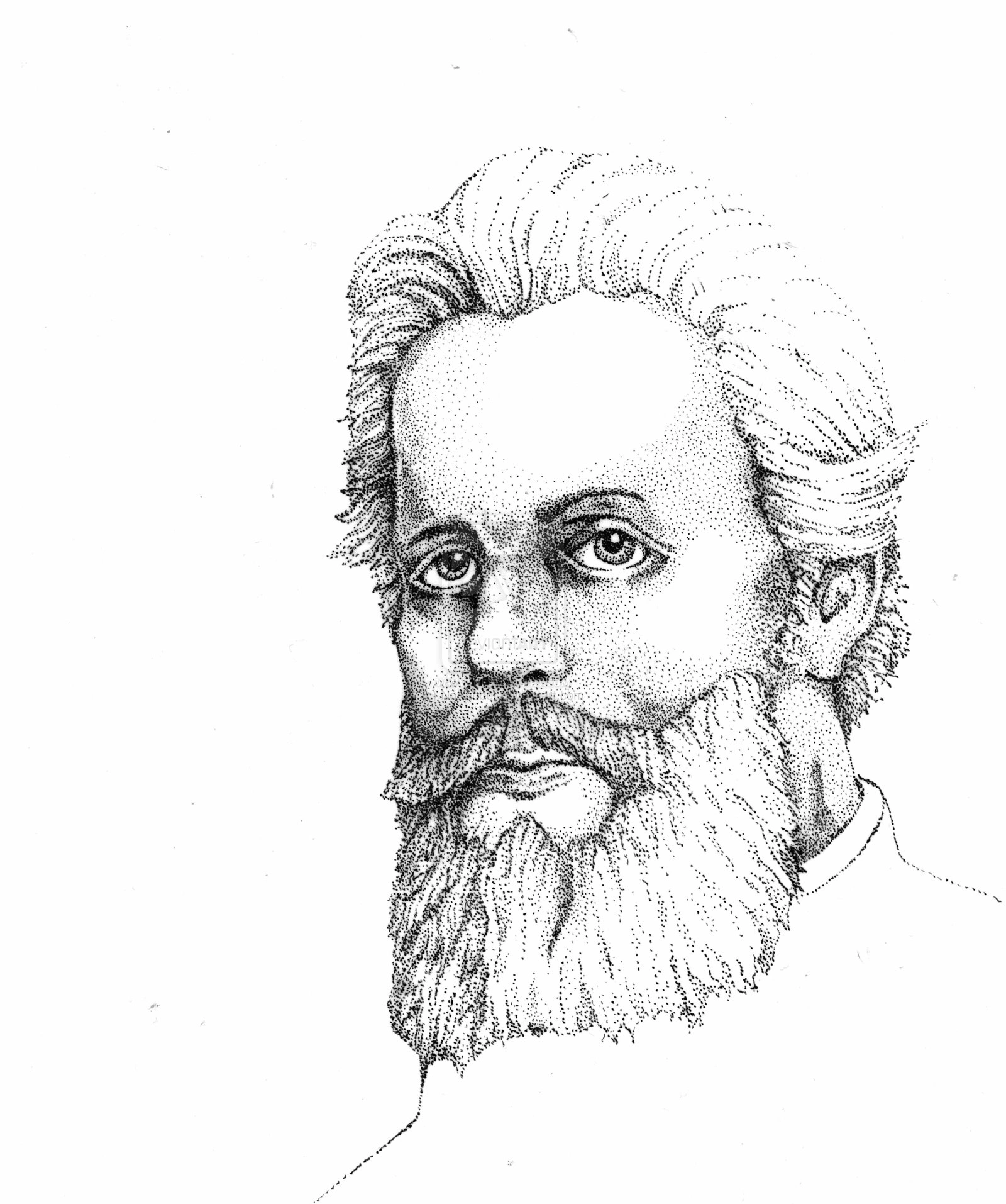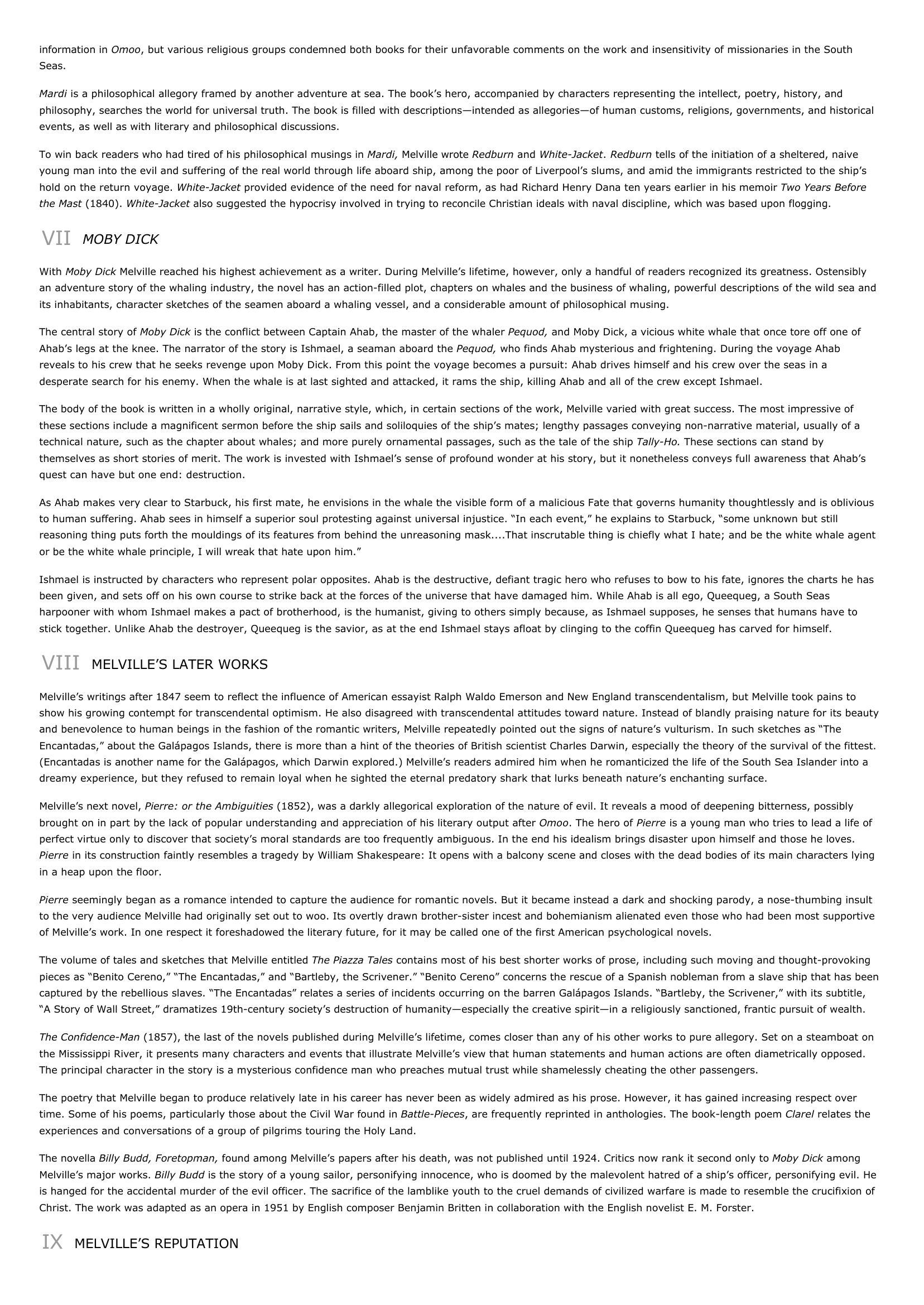Herman Melville.
Publié le 10/05/2013

Extrait du document


«
information in Omoo , but various religious groups condemned both books for their unfavorable comments on the work and insensitivity of missionaries in the South Seas.
Mardi is a philosophical allegory framed by another adventure at sea.
The book’s hero, accompanied by characters representing the intellect, poetry, history, and philosophy, searches the world for universal truth.
The book is filled with descriptions—intended as allegories—of human customs, religions, governments, and historicalevents, as well as with literary and philosophical discussions.
To win back readers who had tired of his philosophical musings in Mardi, Melville wrote Redburn and White-Jacket .
Redburn tells of the initiation of a sheltered, naive young man into the evil and suffering of the real world through life aboard ship, among the poor of Liverpool’s slums, and amid the immigrants restricted to the ship’shold on the return voyage.
White-Jacket provided evidence of the need for naval reform, as had Richard Henry Dana ten years earlier in his memoir Two Years Before the Mast (1840).
White-Jacket also suggested the hypocrisy involved in trying to reconcile Christian ideals with naval discipline, which was based upon flogging.
VII MOBY DICK
With Moby Dick Melville reached his highest achievement as a writer.
During Melville’s lifetime, however, only a handful of readers recognized its greatness.
Ostensibly an adventure story of the whaling industry, the novel has an action-filled plot, chapters on whales and the business of whaling, powerful descriptions of the wild sea andits inhabitants, character sketches of the seamen aboard a whaling vessel, and a considerable amount of philosophical musing.
The central story of Moby Dick is the conflict between Captain Ahab, the master of the whaler Pequod, and Moby Dick, a vicious white whale that once tore off one of Ahab’s legs at the knee.
The narrator of the story is Ishmael, a seaman aboard the Pequod, who finds Ahab mysterious and frightening.
During the voyage Ahab reveals to his crew that he seeks revenge upon Moby Dick.
From this point the voyage becomes a pursuit: Ahab drives himself and his crew over the seas in adesperate search for his enemy.
When the whale is at last sighted and attacked, it rams the ship, killing Ahab and all of the crew except Ishmael.
The body of the book is written in a wholly original, narrative style, which, in certain sections of the work, Melville varied with great success.
The most impressive ofthese sections include a magnificent sermon before the ship sails and soliloquies of the ship’s mates; lengthy passages conveying non-narrative material, usually of atechnical nature, such as the chapter about whales; and more purely ornamental passages, such as the tale of the ship Tally-Ho. These sections can stand by themselves as short stories of merit.
The work is invested with Ishmael’s sense of profound wonder at his story, but it nonetheless conveys full awareness that Ahab’squest can have but one end: destruction.
As Ahab makes very clear to Starbuck, his first mate, he envisions in the whale the visible form of a malicious Fate that governs humanity thoughtlessly and is obliviousto human suffering.
Ahab sees in himself a superior soul protesting against universal injustice.
“In each event,” he explains to Starbuck, “some unknown but stillreasoning thing puts forth the mouldings of its features from behind the unreasoning mask....That inscrutable thing is chiefly what I hate; and be the white whale agentor be the white whale principle, I will wreak that hate upon him.”
Ishmael is instructed by characters who represent polar opposites.
Ahab is the destructive, defiant tragic hero who refuses to bow to his fate, ignores the charts he hasbeen given, and sets off on his own course to strike back at the forces of the universe that have damaged him.
While Ahab is all ego, Queequeg, a South Seasharpooner with whom Ishmael makes a pact of brotherhood, is the humanist, giving to others simply because, as Ishmael supposes, he senses that humans have tostick together.
Unlike Ahab the destroyer, Queequeg is the savior, as at the end Ishmael stays afloat by clinging to the coffin Queequeg has carved for himself.
VIII MELVILLE’S LATER WORKS
Melville’s writings after 1847 seem to reflect the influence of American essayist Ralph Waldo Emerson and New England transcendentalism, but Melville took pains toshow his growing contempt for transcendental optimism.
He also disagreed with transcendental attitudes toward nature.
Instead of blandly praising nature for its beautyand benevolence to human beings in the fashion of the romantic writers, Melville repeatedly pointed out the signs of nature’s vulturism.
In such sketches as “TheEncantadas,” about the Galápagos Islands, there is more than a hint of the theories of British scientist Charles Darwin, especially the theory of the survival of the fittest.(Encantadas is another name for the Galápagos, which Darwin explored.) Melville’s readers admired him when he romanticized the life of the South Sea Islander into adreamy experience, but they refused to remain loyal when he sighted the eternal predatory shark that lurks beneath nature’s enchanting surface.
Melville’s next novel, Pierre: or the Ambiguities (1852), was a darkly allegorical exploration of the nature of evil.
It reveals a mood of deepening bitterness, possibly brought on in part by the lack of popular understanding and appreciation of his literary output after Omoo .
The hero of Pierre is a young man who tries to lead a life of perfect virtue only to discover that society’s moral standards are too frequently ambiguous.
In the end his idealism brings disaster upon himself and those he loves.Pierre in its construction faintly resembles a tragedy by William Shakespeare: It opens with a balcony scene and closes with the dead bodies of its main characters lying in a heap upon the floor.
Pierre seemingly began as a romance intended to capture the audience for romantic novels.
But it became instead a dark and shocking parody, a nose-thumbing insult to the very audience Melville had originally set out to woo.
Its overtly drawn brother-sister incest and bohemianism alienated even those who had been most supportiveof Melville’s work.
In one respect it foreshadowed the literary future, for it may be called one of the first American psychological novels.
The volume of tales and sketches that Melville entitled The Piazza Tales contains most of his best shorter works of prose, including such moving and thought-provoking pieces as “Benito Cereno,” “The Encantadas,” and “Bartleby, the Scrivener.” “Benito Cereno” concerns the rescue of a Spanish nobleman from a slave ship that has beencaptured by the rebellious slaves.
“The Encantadas” relates a series of incidents occurring on the barren Galápagos Islands.
“Bartleby, the Scrivener,” with its subtitle,“A Story of Wall Street,” dramatizes 19th-century society’s destruction of humanity—especially the creative spirit—in a religiously sanctioned, frantic pursuit of wealth.
The Confidence-Man (1857), the last of the novels published during Melville’s lifetime, comes closer than any of his other works to pure allegory.
Set on a steamboat on the Mississippi River, it presents many characters and events that illustrate Melville’s view that human statements and human actions are often diametrically opposed.The principal character in the story is a mysterious confidence man who preaches mutual trust while shamelessly cheating the other passengers.
The poetry that Melville began to produce relatively late in his career has never been as widely admired as his prose.
However, it has gained increasing respect overtime.
Some of his poems, particularly those about the Civil War found in Battle-Pieces , are frequently reprinted in anthologies.
The book-length poem Clarel relates the experiences and conversations of a group of pilgrims touring the Holy Land.
The novella Billy Budd, Foretopman, found among Melville’s papers after his death, was not published until 1924.
Critics now rank it second only to Moby Dick among Melville’s major works.
Billy Budd is the story of a young sailor, personifying innocence, who is doomed by the malevolent hatred of a ship’s officer, personifying evil.
He is hanged for the accidental murder of the evil officer.
The sacrifice of the lamblike youth to the cruel demands of civilized warfare is made to resemble the crucifixion ofChrist.
The work was adapted as an opera in 1951 by English composer Benjamin Britten in collaboration with the English novelist E.
M.
Forster.
IX MELVILLE’S REPUTATION.
»
↓↓↓ APERÇU DU DOCUMENT ↓↓↓
Liens utiles
- Le personnage de CERENO Benito Herman Melville
- BLOUSE BLANCHE (La) Herman Melville (résumé & analyse)
- BILLY BUDD, GABIER DE MISAINE Herman Melville (résumé & analyse)
- PIERRE ou Les ambiguïtés Herman Melville (résumé)
- OMOO Herman Melville - résumé, analyse















